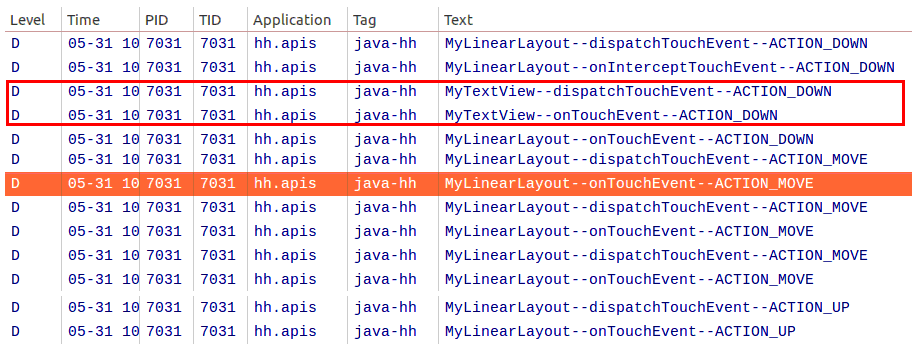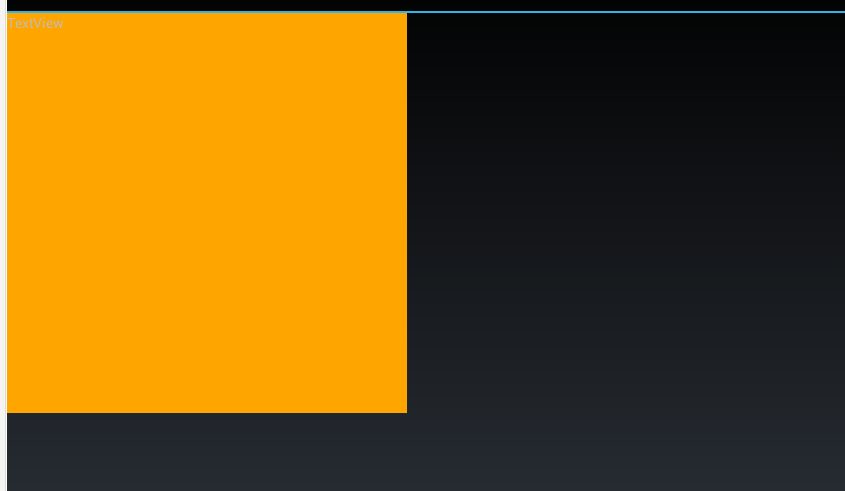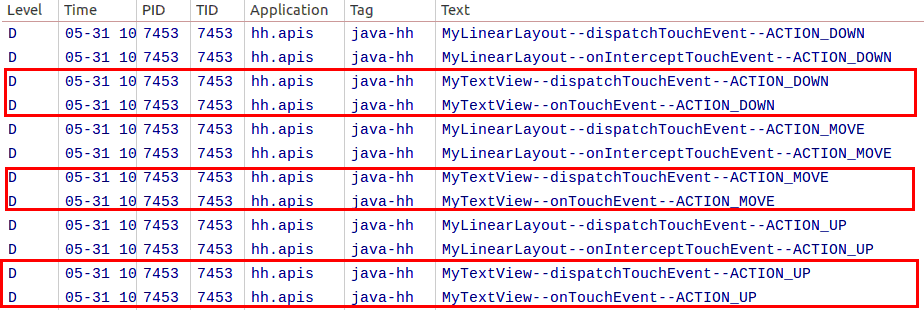参考1:http://www.oschina.net/question/163910_27289
1. 默认情况输出结果。
LinearLayout代码
public class Theory1_MyLinearLayout extends LinearLayout {
public Theory1_MyLinearLayout(Context context) {
super(context);
// TODO Auto-generated constructor stub
}
public Theory1_MyLinearLayout(Context context, AttributeSet attrs) {
super(context, attrs);
// TODO Auto-generated constructor stub
}
public Theory1_MyLinearLayout(Context context, AttributeSet attrs, int defStyle) {
super(context, attrs, defStyle);
// TODO Auto-generated constructor stub
}
@Override
public boolean onTouchEvent(MotionEvent event) {
// TODO Auto-generated method stub
int action = event.getAction();
switch (action) {
case MotionEvent.ACTION_DOWN:
Log.d(Constant.DEBUG_TAG, "MyLinearLayout--onTouchEvent--ACTION_DOWN");
break;
case MotionEvent.ACTION_MOVE:
Log.d(Constant.DEBUG_TAG, "MyLinearLayout--onTouchEvent--ACTION_MOVE");
break;
case MotionEvent.ACTION_UP:
Log.d(Constant.DEBUG_TAG, "MyLinearLayout--onTouchEvent--ACTION_UP");
break;
case MotionEvent.ACTION_CANCEL:
Log.d(Constant.DEBUG_TAG, "MyLinearLayout--onTouchEvent--ACTION_CANCEL");
break;
}
return super.onTouchEvent(event);
}
@Override
public boolean onInterceptTouchEvent(MotionEvent ev) {
// TODO Auto-generated method stub
int action = ev.getAction();
switch (action) {
case MotionEvent.ACTION_DOWN:
Log.d(Constant.DEBUG_TAG, "MyLinearLayout--onInterceptTouchEvent--ACTION_DOWN");
break;
case MotionEvent.ACTION_MOVE:
Log.d(Constant.DEBUG_TAG, "MyLinearLayout--onInterceptTouchEvent--ACTION_MOVE");
break;
case MotionEvent.ACTION_UP:
Log.d(Constant.DEBUG_TAG, "MyLinearLayout--onInterceptTouchEvent--ACTION_UP");
break;
case MotionEvent.ACTION_CANCEL:
Log.d(Constant.DEBUG_TAG, "MyLinearLayout--onInterceptTouchEvent--ACTION_CANCEL");
break;
}
return super.onInterceptTouchEvent(ev);
}
@Override
public boolean dispatchTouchEvent(MotionEvent ev) {
// TODO Auto-generated method stub
int action = ev.getAction();
switch (action) {
case MotionEvent.ACTION_DOWN:
Log.d(Constant.DEBUG_TAG, "MyLinearLayout--dispatchTouchEvent--ACTION_DOWN");
break;
case MotionEvent.ACTION_MOVE:
Log.d(Constant.DEBUG_TAG, "MyLinearLayout--dispatchTouchEvent--ACTION_MOVE");
break;
case MotionEvent.ACTION_UP:
Log.d(Constant.DEBUG_TAG, "MyLinearLayout--dispatchTouchEvent--ACTION_UP");
break;
case MotionEvent.ACTION_CANCEL:
Log.d(Constant.DEBUG_TAG, "MyLinearLayout--dispatchTouchEvent--ACTION_CANCEL");
break;
}
return super.dispatchTouchEvent(ev);
}
}再看下MyTextView代码
public class Theory1_MyTextView extends TextView {
public Theory1_MyTextView(Context context) {
super(context);
// TODO Auto-generated constructor stub
}
public Theory1_MyTextView(Context context, AttributeSet attrs) {
super(context, attrs);
// TODO Auto-generated constructor stub
}
public Theory1_MyTextView(Context context, AttributeSet attrs, int defStyle) {
super(context, attrs, defStyle);
// TODO Auto-generated constructor stub
}
@Override
public boolean onTouchEvent(MotionEvent event) {
// TODO Auto-generated method stub
int action = event.getAction();
switch (action) {
case MotionEvent.ACTION_DOWN:
Log.d(Constant.DEBUG_TAG, "MyTextView--onTouchEvent--ACTION_DOWN");
break;
case MotionEvent.ACTION_MOVE:
Log.d(Constant.DEBUG_TAG, "MyTextView--onTouchEvent--ACTION_MOVE");
break;
case MotionEvent.ACTION_UP:
Log.d(Constant.DEBUG_TAG, "MyTextView--onTouchEvent--ACTION_UP");
break;
case MotionEvent.ACTION_CANCEL:
Log.d(Constant.DEBUG_TAG, "MyTextView--onTouchEvent--ACTION_CANCEL");
break;
}
return super.onTouchEvent(event);
}
@Override
public boolean dispatchTouchEvent(MotionEvent ev) {
// TODO Auto-generated method stub
int action = ev.getAction();
switch (action) {
case MotionEvent.ACTION_DOWN:
Log.d(Constant.DEBUG_TAG, "MyTextView--dispatchTouchEvent--ACTION_DOWN");
break;
case MotionEvent.ACTION_MOVE:
Log.d(Constant.DEBUG_TAG, "MyTextView--dispatchTouchEvent--ACTION_MOVE");
break;
case MotionEvent.ACTION_UP:
Log.d(Constant.DEBUG_TAG, "MyTextView--dispatchTouchEvent--ACTION_UP");
break;
case MotionEvent.ACTION_CANCEL:
Log.d(Constant.DEBUG_TAG, "MyTextView--dispatchTouchEvent--ACTION_CANCEL");
break;
}
return super.dispatchTouchEvent(ev);
}
}最后看下布局文件代码
<?xml version="1.0" encoding="utf-8"?>
<hh.theory.Theory1_MyLinearLayout xmlns:android="http://schemas.android.com/apk/res/android"
android:layout_width="match_parent"
android:layout_height="match_parent"
android:orientation="vertical" >
<hh.theory.Theory1_MyTextView
android:id="@+id/textView1"
android:layout_width="400dp"
android:layout_height="400dp"
android:background="@color/orange"
android:text="TextView" />
</hh.theory.Theory1_MyLinearLayout>显示的图片为:
对比:
1. 在黑色部分Touch的输出结果
2. 在橙色部分Touch的输出结果
结论:
默认的情况下是MyLinearLayout的dispatchTouchEvent最先接收到ACTION_DOWN,然后分发给MyTextView(其子View)。
一个问题,这里网速买只有DOWN,而没有MOVE和UP呢?
很简单,请看Theory1_MyLinearLayout.onTouchEvent中的action为ACTION_DOWN的返回值,是super.onTouchEvent(event);
经过本人的测试,发现LinearLayout的super.onTouchEvent(event);返回false;
这是什么意思?
注释部分是:* @return True if the event was handled, false otherwise.“
其实就是表示我们的MyLinearLayout没有处理这个ACTION_DOWN,因此后面的MOVE, UP都不接收了。
2. 仅将Theory1_MyLinearLayout.onTouchEvent中的action为ACTION_DOWN的返回值为true的情况
经过修改后的MyLinearLayout.onTouchEvent的代码为:
@Override
public boolean onTouchEvent(MotionEvent event) {
// TODO Auto-generated method stub
int action = event.getAction();
switch (action) {
case MotionEvent.ACTION_DOWN:
Log.d(Constant.DEBUG_TAG, "MyLinearLayout--onTouchEvent--ACTION_DOWN");
return true;
//break;
case MotionEvent.ACTION_MOVE:
Log.d(Constant.DEBUG_TAG, "MyLinearLayout--onTouchEvent--ACTION_MOVE");
break;
case MotionEvent.ACTION_UP:
Log.d(Constant.DEBUG_TAG, "MyLinearLayout--onTouchEvent--ACTION_UP");
break;
case MotionEvent.ACTION_CANCEL:
Log.d(Constant.DEBUG_TAG, "MyLinearLayout--onTouchEvent--ACTION_CANCEL");
break;
}
return super.onTouchEvent(event);
}2.1 在黑色部分轻扫的结果
可以看到dispatchTouchEvent和onTouchEvent是一一对应关系。。。
2.2 在MyTextView所占的橙色部分轻扫的结果

可见,MyTextView因为没有在Action为DOWN的时候返回true,表明这个MyTextView不想接收MOVE以及UP,所以该MyTextView没有接收到MOVE和UP消息。
为了印证我的结果,我将MyTextView中onTouchEvent的ACTION_DOWN返回true,然后在橙色部分轻扫,下面是结果:
这下真相大白了吧,因为MyTextView也接收了ACTION_DWON,那么此后的MyLinearLayout的onTouchEvent就接收不到MOVE和UP了。
// End up with 2013/5/31 == 18:35
///



























 576
576

 被折叠的 条评论
为什么被折叠?
被折叠的 条评论
为什么被折叠?








